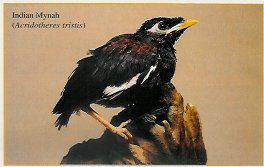|
WILD BIRD RESCUE

The common or Indian Mynah (Acridotheres tristis) is not an indigenous South African bird. It may, therefore, be taken from the wild and kept in captivity without a permit. As they compete with our birds for nesting site and food, no responsible rehabilitation centre ever releases a Mynah back into the wild. They always need good homes for rescued Mynahs. Mynahs make wonderful pets. Fulfill your moral obligations to any living creature in your home; give them love and excellent care. Wild-caught adults will never make good pets. You need to get a baby, and raise it yourself or adopt (a donation is appropriate) one from a rescue rehabilitation centre.
SUITABLE CAGES: As big as possible. A minimum size for a cage is 600 millimeters wide. Rectangular, not round. Use non-poisonous natural perches, which can be discarded when dirty. Vary the thickness of the perches in the cage. Do not clutter the cage.
FEEDING: The basic diet should consist of diced fruit in season, mixed with Avi-Plus Mynah & Softbill mix (or Pronutro in an emergency). Small amounts of hard-boiled egg, grated cheese and lean mince treats. Offer any available mealworms or other live insects from the hand. Offer clean drinking and bathing water daily. All water and food dishes must be washed and disinfected daily.
DEWORMING: This should be done twice a year. Get a suitable product from your vet.
TAMING: The bird must have at least an hour outside its cage everyday. Keep your Mynahís wings clipped at all times. Keep the bird in an area of regular, quiet human activity. Always move quietly and gently. Offer favourite foods from the hand.
TEACHING TO SPEAK: There is a horrible, cruel, untrue old wives tale that you should split a birdís tongue before you can teach it to talk. Please do not believe any such thing. Never submit your Mynah (or any other bird) to such unspeakable cruelty!
Keep your pupil away from other birds. Teach a young bird and be regular with your lessons. Start with a short phrase of about three words. Repeat the phrase clearly and slowly (keeping the words setperate) for 10 to 15 minutes twice a day. A small tape recorder can do wonders for this task. After a few weeks you should hear your Mynah trying to say the phrase.
Immediately repeat it for the bird, slowly and clearly. Reward it with itís favourite treat. It will soon be saying it perfectly, in your voice, with your accent. Donít start a new phrase until it has mastered the old one. As long as you keep up the lessons, it will keep expanding its vocabulary.
Enjoy your Mynah
By Gordon M Duncan & Wings in Need
Animaltalk April 1999
< Back
|













